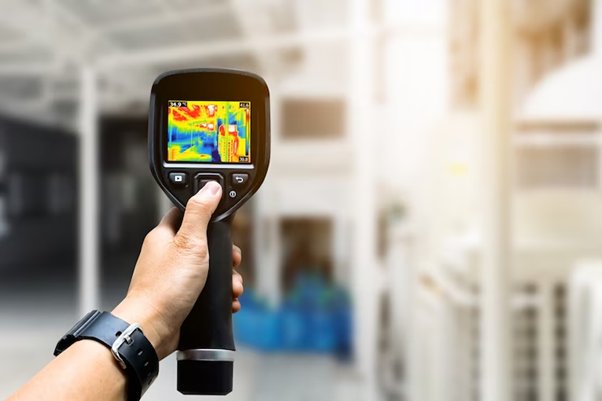A thermal imager (infrared camera, thermal imaging device) captures images in the infrared wavelength range. In other words, a thermal imager is an optoelectronic system designed to obtain a visible image of objects emitting invisible thermal (infrared) radiation. Most often, a thermal imager is used as a night vision device or to get the temperature field of an object. With a thermal imager, you can instantly measure the temperature of tens of thousands of points on an object. Thermal imaging cameras are measuring devices, sometimes called thermal imaging cameras.
The first thermal imaging cameras were created in the 30s of the 20th century. The principle of operation of a thermal imager is based on the conversion of infrared radiation into an electrical signal, which is amplified and reproduced on the screen of the indicator.
In the 70s, thermal imagers were created, in which thermal images were converted into visible images directly on the screen covered with photosensitive substances (phosphors, liquid crystals, semiconductor films). Thermal imagers are used to determine the location and shape of objects in the dark or optically opaque environments.
Modern thermal imaging cameras are widely used at large industrial enterprises, where it is necessary to control the thermal state of objects carefully, and in small organizations engaged in troubleshooting networks for various purposes. For example, scanning with a thermal imager can unmistakably show where contacts in wiring systems are loose.
Because thermal imaging is passive, non-contact detection and identification of targets, it is hidden and undetectable, making a long-range thermal camera safer and more efficient for operators. In addition, do you know what other benefits thermal imaging cameras offer? Let’s take a detailed look at them.
The Long-Distance Thermal Camera Is Highly Detectable
The long-distance thermal camera is widely detectable and has a long-range operation. Using infrared thermal imaging technology, you can see beyond the range of the enemy’s defensive weapons and have long-range performance.
- Control and light weapons mounted on thermal domains allow the user to see the human body at distances of over 800m
- They can be used at distances of 2 to 3 km for targeting and firing
- On board ships, they can observe water up to 10km
An Accurate 24/7 Surveillance System
Infrared radiation is the most common radiation in nature. At the same time, the atmosphere and smoke clouds absorb visible and near-infrared light but are transparent to infrared light from 3 to 5 microns and 8 to 14 microns, known as the atmospheric window for infrared light. These two wavelengths are known as the atmospheric window for infrared light.
They provide a clear view of the target at night when there is no light or in harsh conditions such as rain or snow where there is a lot of smoke and clouds. Because of this feature, a long-range thermal camera can be used for 24/7 monitoring.
The thermal camera visualizes the temperature field on the surface of an object
The thermal camera visualizes the temperature field on the surface of an object, regardless of bright light. Thermal imaging technology visualizes the temperature field on the surface of an object, independent of glare, and allows monitoring in the presence of obstacles such as trees and grass.
While an infrared thermometer can only display the temperature value of a small area or point on the surface of an object, the thermal domain measures the temperature at all points on the surface, simultaneously visualizes the temperature field on the object’s surface, and displays it as an image.





